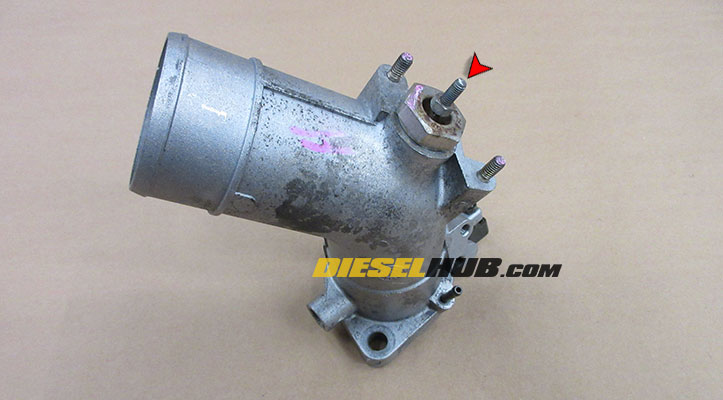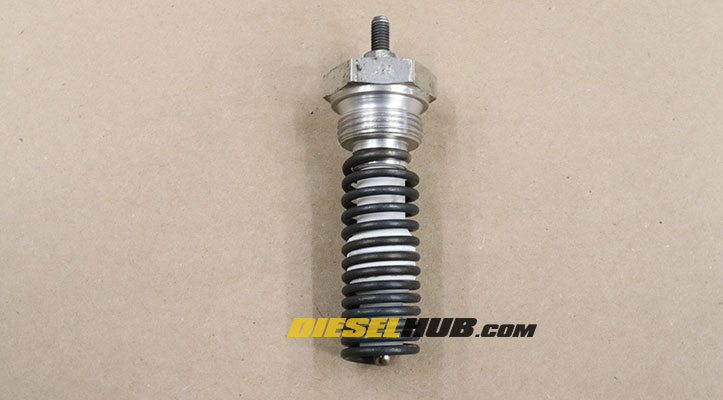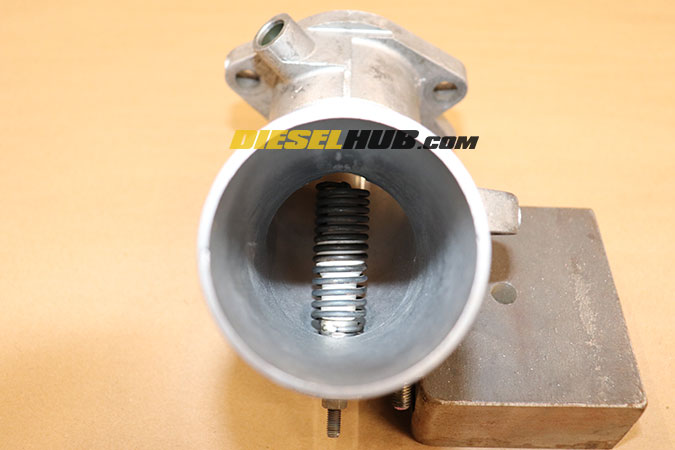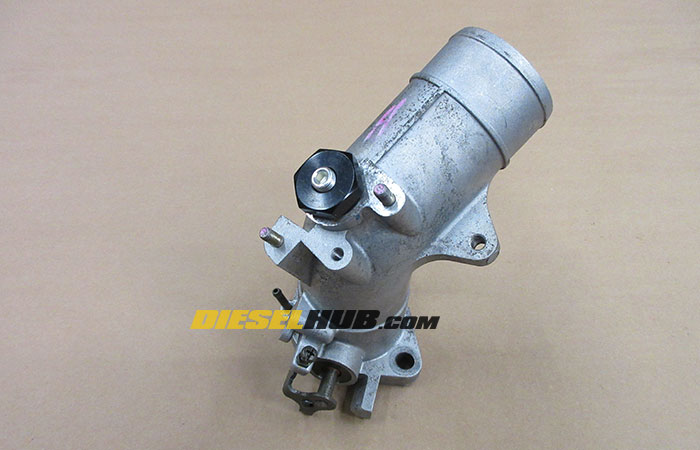IAH overview
The intake air heater (IAH, air intake heater, AIH) is a resistive heating element found in the cold-side intake manifold tube (air horn, intake elbow) of 2001 to 2004 model year GMC Sierra and Chevrolet Silverado pickups equipped with the 6.6L Duramax diesel (LB7). Under certain conditions, the IAH is activated to heat the incoming air charge before it enters the intake manifold. While it is often mistaken as a cold starting aid, it is in fact a cold running aid intended to reduce emissions and help the engine run more efficiently following a cold start.

The IAH is mounted in the upper intake manifold tube next to the MAP sensor on the cold-side of the intake system (post-intercooler). It is controlled by the ECM and actuated by a relay in the glow plug control module (GPCM), which is mounted on the rear section of the driver side valve cover. Later versions of the Duramax diesel adopted a grid heater type system designed for the same purpose, but this article focuses on the cylindrical IAH found on LB7 engines.

IAH parameters
The intake air heater is initially cycled ON when the following conditions are met:
- Battery voltage is >= 10 volts AND battery voltage <= 18 volts
- Intake air temperature (IAT) <= 73.4° F (23° C) OR engine coolant temperature (ECT) <= 121.1° F (49.5° C)
The ECM will then cycle the IAH ON for several seconds and monitor its activity. If there are any discrepancies in the operation of the IAH in either the OFF or ON states, the ECM will set a DTC and the service engine soon (SES) light will be illuminated in the dash. The four codes commonly associated with an IAH fault are P0504, P0543, P0151, and P0542. An under-voltage, over-voltage, or open (no continuity through IAH circuit) condition will trigger one or more of these DTCs during the test cycle. After the engine has started, the duration that the IAH remains ON is dependent on the IAT and ECT readings, as provided by their respective sensors.
Benefits of the IAH System
By providing the engine with a warmer intake air charge, combustion efficiency is improved when the engine is cold and the ambient temperature is low. As the ambient air temperature lowers, so do the benefits provided by the IAH. It should be noted that a "cold" engine refers to one that has sat long enough (engine OFF) such that it has reached an equilibrium temperature approximately equal to that of its surroundings. Since diesel engines rely on the heat of compression for ignition, a cold engine may exhibit inefficient combustion when the engine is cold; the engine block, cylinder head, and pistons are effectively acting as giant heat sinks, robbing the air-fuel mixture of much of the heat required for complete combustion to occur. Increasing the temperature of the intake air charge helps dampen these effects, allowing the engine to run smoother. As a result, a functioning IAH may provide the following benefits, particularly in extremely cold ambient conditions:
- Reduced fuel dilution during engine warm-up period (reduces "wet stacking")
- Reduced engine warm-up time, reaching operating temperature faster
- Reduced emissions during warm-up cycle due to improved combustion efficiency, more complete combustion (less smoke)
- Smoother engine operation during warm-up period following a cold start
Disadvantages of the IAH System

If you operate your Duramax in freezing, below freezing, or arctic conditions, the benefits of a fully functioning IAH completely outweigh those realized by removing it. That being said, the greatest disadvantage of the intake air heater is its size relative to that of the intake tube. The accumulative cross sectional area of the IAH, including its asymmetrical profile and series of resistive coils, is approximately 1.35 in2. With a diameter of ~2.175 in, the intake tube has a cross sectional area of approximately 3.71 in2. Thus, the profile of the IAH covers 36% of the cross sectional area of the intake tube. While this is a significant amount of real estate, the IAH is not a blunt restriction within the intake tract. Its profile is relatively smooth with rounded features that easily allow air to flow around it without being excessively burdensome to the flow pattern of the air charge. However, it's still a restriction nonetheless and thus there are benefits, however small, to be gained by deleting it. Removing the IAH and plugging the hole in the intake tube may have the following advantages:
- Increased overall airflow, particularly at higher engine speeds and loads
- Improved throttle response, although the actual gains vary considerably and are debatable
- Reduced battery load at startup and during engine warm up, times when the batteries are most vulnerable (the IAH is fed through a 175 amp fuse, suggesting it has the potential to draw a large amount of current)
- Provides a convenient location to mount a boost pressure sensor/supply tube for an aftermarket gauge or fitting for injectables, such as water-methanol
How to Delete the IAH on a 2001 - 2004 Duramax Diesel
Deleting the IAH is as simple as replacing it with an appropriately threaded plug and securing the power wire/terminal to eliminate the risk of shorting the circuit.
- Remove the power terminal from the top of the IAH
- Remove the IAH from the intake tube using a 26 mm socket (a 1 inch socket also fits snug)
- Install the IAH plug snug in the intake tube
- Tape up/heat shrink the power terminal and secure it so that it is not at risk for chaffing
Note that this WILL set a DTC (diagnostic trouble code); read below for more information on suppressing the DTC and keeping the SES light from illuminating. With the IAH removed and the hole plugged, the power wire must be secured so that it will not short circuit when the ECM attempts to activate the IAH. Electrical tape and heat shrink tubing should be used to completely cover all exposed areas of the terminal, and the wire should be secured accordingly to prevent chaffing.

Delete Plug Options
The thread size of the IAH is 22 mm x 1.5. There are many commercially available, reasonably priced AIH delete plugs available on the market. If a tapped bung is desired for attaching a boost gauge or other accessory, this is the best choice. Note that the IAH found on a Duramax LB7 has the same threads as the IAH found on a 7.3L Power Stroke, thus any IAH plug advertised for a 7.3L Power Stroke WILL also fit a Duramax LB7; some solutions are advertised for both engines, others are not.
For a cheaper solution, simply acquire an oil pan drain plug for a 1998 - 2002 Dodge Ram 2500/3500 with a 24v Cummins turbodiesel. This drain plug has the correct threads and typically costs under $10. We do NOT recommend cutting/modifying the IAH in order to convert it into a non-functioning plug. In fact, you should not discard the IAH because you may wish to reinstall it during the cooler months.
| Description | Part Number | Remarks |
| Fleece Performance IAH plug | FPE-LB7-IAH-DELETE | Premium CNC machined aluminum plug, drilled and tapped port for boost gauge line/sensor |
| GlowShift IAH plug | GS-FA_73_AIHBP | Economical aluminum plug, drilled and tapped port for boost gauge line/sensor |
| 1998 - 2002 Cummins oil pan drain plug | Dorman 65384 | M22x1.5 threads, includes gasket, economical IAH delete option |
How to Eliminate a DTC After Deleting the IAH
When the aforementioned parameters are met the IAH system will self-diagnose and set a DTC if there are any inconsistencies in the operation of the IAH circuit; with the terminal disconnected, the ECM is going to identify an open circuit when it runs this test and set a DTC. The only positive method of eliminating the DTC from being set is to program the IAH function OFF, which requires a programmer/tuner with such functionality; note that not all products on the market offer this feature, and you should contact the manufacturer of individual products to verify their capabilities.
While there are also several "workarounds" that fool the ECM into thinking that the IAH is still connected and functioning properly when it is indeed removed, none of the solutions we have reviewed are ideal nor necessarily safe; proceed at your own risk.
Summary
As the vehicle owner, you need to evaluate whether the advantages of deleting the IAH outweigh the downfalls, which will be primarily based on the weather patterns in your specific region. Keep in mind that a highly modified engine is going to find more benefit in deleting the IAH than an entirely stock one. If deleting the IAH, keep it in your toolbox so it can quickly be reinstalled during the colder months as it is deemed necessary. Fortunately, this modification is both easily reversible and relatively inexpensive, so it may be worth testing yourself.